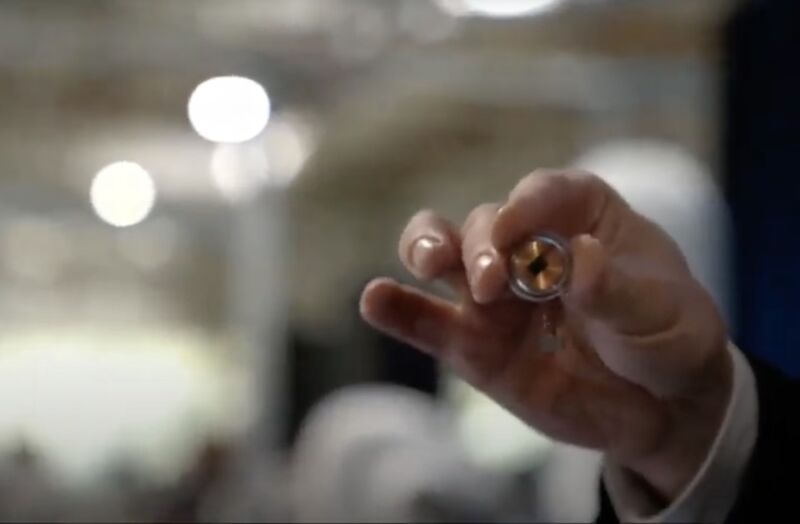Musk says that Neuralink implants are close to ready for human testing

On Friday, Elon Musk gave an update on what’s probably his third-most prominent company: Neuralink. Neuralink had been pretty low profile (especially in comparison to Tesla and SpaceX) prior to this time last year, which is when Musk first went into detail about the company’s goals and progress. And the goals were striking: a mass-market brain implant that could be installed by a robot via same-day surgery.
With this year’s update, little has changed about the overall plan, but plenty of little details have been tweaked in the intervening 12 months. And progress has been made, in that Musk introduced his audience to a group of pigs who were already carrying what he suggested was version 0.9 of his implants, with human testing set to follow shortly.
Designs on the brain
One of the big differences between this year and last is the overall design of the implant and its supporting hardware. The original goal had been to keep the surgery simple in part by minimizing the size of the hole that needed to be made in the skull. This meant a small-diameter implant that wouldn’t necessarily be placed near the neurons it interacted with and would require a connection to separate hardware placed behind the ear. All of this added to the level of complication and would necessarily require running some wires across the surface of the brain.
Most of that’s been simplified away. For now, rather than attempting to target anything deep in the brain, implants will only target things near the surface of the cerebral cortex, the outermost layer at the front of the brain. A neurosurgeon employed by Neuralink was on hand (in scrubs, as he was last year, just so you knew he was a surgeon) and said that there are lots of motor and sensory processes that route through the cortex and thus can be targeted by these implants. Musk followed up on that by saying that we can “solve” blindness and deafness solely by focusing on the cortex.
As in the old design, roughly 1,000 electrodes will be inserted into the targeted collection of neurons, and those will connect to an implant above the surface of the brain. But in this case, they’ll do so by the shortest route possible, eliminating the need to run the wires across the surface of the brain. The behind-ear hardware is gone as well. Instead, there will be a single implant that spans the skull, essentially replacing part of it.
Musk showed off one of the implants, and it represents a major rethinking. He said it was 23mm across (though he didn’t specific radius or diameter) and about 8mm thick—the latter chosen as a close match to the thickness of human skulls. The device looks like a very thick coin or miniature hockey puck, and it contains all the hardware needed to keep the implant functional. This includes a battery large enough for all-day operation and the hardware needed for wireless inductive charging. There are also support chips, mostly derived from wearables, that control the charging and enable wireless communication via Bluetooth.
Spikes
But the central feature is still Neuralink’s custom chip designed to identify and transmit patterns of neural activity. Individual neurons, which the electrodes will be listening in on, communicate by firing off a series of what are called “spikes”—short bursts of electrical activity that stand out from the background noise. Musk said that Neuralink’s chip comes programmed with a set of spike templates that match the usual range of behaviors seen in actual neurons. The chip will take the analog electrical activity recorded by the electrodes, convert it to digital data, identify any spikes of activity, and then find the template spike that matches the activity best.
That allows it to transmit a code that identifies the template, making for a huge compression compared to the complicated, noisy neural activity. It’s absolutely necessary for a device that will be communicating via a low-bandwidth interface like Bluetooth.
The chip will also allow the electrodes to be used to stimulate neurons, although Musk didn’t go into the details on this. It presumably takes a bit more power than passively reading their activity, which may limit how much this can be used.
Putting it in place
The team is still counting on a robot to do the hardest parts of the implant, using a microscope to identify and avoid blood vessels when threading electrodes into the brain. The prototype robot that Neuralink showed off last year, which could easily have been mistaken for an interrogation droid, is no more. In its place is a clean, white, very medical-looking design—one with all the tools and pointy bits necessary for putting a hole in someone’s skull kept from view while not in use. While the team is still working on adapting the robot to reach deeper areas in the brain, the initial focus on the cortex makes the robot’s task somewhat easier for now.
Musk promised…
Read More: Musk says that Neuralink implants are close to ready for human testing

